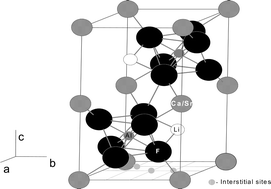Computer modelling of mixed metal fluorides for optical applications†
Abstract
This paper describes a new computational method for predicting the optical behaviour of doped inorganic materials. There is considerable interest in using inorganic materials in photonic devices, and in many cases, the optical properties of these materials depend on doping by ions such as those from the rare earth series. Among the inorganic materials of interest are the mixed metal fluorides (e.g. BaLiF3, BaY2F8, YLiF4, LiCaAlF6, LiSrAlF6), doped with trivalent rare earth ions. The paper describes the use of Mott–Littleton calculations to determine the optimum location for dopant ions, followed by crystal field calculations which make direct use of the output of the Mott–Littleton calculations to calculate the optical properties of the dopant ion taking into account its symmetry and the positions of the surrounding ions, including any vacancies or interstitial ions present by virtue of charge compensation. It is then possible to predict whether a given dopant ion at a particular site in a material will have favourable optical properties.


 Please wait while we load your content...
Please wait while we load your content...